Join my VIP teacher email club!

When I look back to my first experience teaching five paragraph essays to fifth graders, I can remember how terribly unprepared I felt.
I knew that the five paragraph essay format was what my students needed to help them pass our state’s writing assessment but I had no idea where to start.
I researched the few grade-appropriate essays I could find online (these were the days before Pinterest and Teachers Pay Teachers) and determined that there was a structure to follow.
Every essay followed the same basic structure. I taught the structure to my students and they did well.
I have been teaching five paragraph essay structure and everything that goes with it for several years now. I hope that after you read this blog post, you will have a good understanding of how to teach and grade five paragraph essays.
Once you’ve learned all about teaching basic essay structure, you’ll be ready to grow your writers from “blah” to brilliant!
Teaching five paragraph essays is just one part of teaching 5th grade writing. Click here to find out exactly how I teach writing to my 5th graders!


Start with Simple Paragraphs
We always start with simple paragraphs.
Yes, this is basic, but if your students cannot write excellent paragraphs, their five paragraph essays will be train wrecks. Trust me!
We spend a while cementing paragraph structure:
Topic Sentence
Closing Sentence
I give students topics, they come up with their own topics, we write together, they write with a partner or independently, the more variety, the better.
We have fun with simple paragraphs. Then, it’s time to move on to body paragraphs.

Organize and Write Body Paragraphs
Please refer to my five paragraph essay organizer below.
The three body paragraphs are absolutely crucial to the success of the five paragraph essay.
Some teachers have trouble teaching the structure of five paragraph essays because they start with the introduction paragraph.
Always teach the body paragraphs first!

I had a teacher say to me once, “What’s the point of just writing parts of the essay? They need to write the entire five paragraphs to get all of the practice they need.”
I understand that point. However, think of it as building a house. Should you test out the foundation and make sure it’s sound and sturdy before building on top of it? Absolutely! That’s what we’re doing here.
The three body paragraphs are the foundation of the essay.
Ask students to write out their three body paragraphs just like they have practiced…Topic sentence…Detail 1…Detail 2…Detail 3…Closing Sentence.
I “ooooh and aaaah” over their three paragraphs. Students are on their way to five paragraph essays, so be sure to build their confidence.

Teach the Introduction Paragraph
I have to say, this is my favorite paragraph to teach. The introduction paragraph is what draws readers into the essay and makes them want to read more.
We start with what I call a “hook.” The hook captures the readers’ attention and can come in many forms: asking a question, making a bold statement, sharing a memory, etc.
After the hook, I ask students to add a sentence or two of applicable commentary about the hook or about the prompt in general.
Finally, we add the thesis sentence. The thesis sentence always follows the same formula: Restate the prompt, topic 1, topic 2, and topic 3.
That’s all you need to write an excellent introduction paragraph!
I do suggest having students write the introduction paragraph plus body paragraphs a couple of times before teaching the closing paragraph.

Teach the Closing Paragraph
In the conclusion paragraph, we mainly focus on restating the thesis and including an engaging closing thought.
With my students, I use the analogy of a gift.
The introduction paragraph and body paragraphs are the gift and the conclusion paragraph is the ribbon that ties everything together and finishes the package.
When you talk about restating the thesis sentence, tell students that they need to make it sound different enough from their original thesis sentence to save their readers from boredom.
Who wants to read the same thing twice? No one!
Students can change up the format and wording a bit to make it fresh.
I enjoy teaching the closing thought because it’s so open to however students want to create it.
Ways to write the closing thought: ask a question, personal statement, call to action, or even a quote.
I especially like reading the essays in which a quote is used as a closing thought or a powerful statement is used.

Example of a full five paragraph essay

Let’s Talk About Color-Coding!
Who doesn’t like to color? This is coloring with a purpose!
Training your students to color-code their paragraphs and essays will make grading so much easier and will provide reminders and reinforcements for students.
When students color-code their writing, they must think about the parts of their paragraphs, like topic sentences, details, and the closing sentence.
They will be able to see if they are missing something or if they’ve written something out of order.
Color-coding is a wonderful help for the teacher because you can skim to ensure that all parts of your students’ paragraphs and essays are present.
Also, when you are grading, you can quickly scan the paragraphs and essays. Trust me, you will develop a quick essay-grading ability.
I start color-coding with my students at the very beginning when they are working on simple paragraphs. I add the additional elements of the color-code as we progress through our five paragraph essays.
This is the code that I use:

Let’s Talk About Grading Five Paragraph Essays!
Imagine a lonely, stressed teacher grading five paragraph essays on the couch while her husband is working the night shift.
That was me!
Seriously, guys, I would spend about ten minutes per essay. I marked every little error, I made notes for improvement and notes of encouragement. I reworked their incorrect structure.
Those papers were full of marks.
On Monday, I proudly brought back the essays and asked students to look over them and learn what they needed to fix for next time.
You can guess what happened… there were lots of graded essays in the trashcan at the end of the day.

I decided that my grading practices had to change. I needed my weekends back and my students needed to find their own errors!
This is my best advice:
STOP correcting every error!
Your students are not benefiting from marks all over their writing. They need to find those errors themselves so that they will remember their mistakes and change their writing habits.
Do a quick scan of each student’s writing as soon as it’s turned in to you.
If there are major problems with a student’s writing, call him/her over individually and show him/her what needs to be fixed or put the student with a competent peer editor who will help them fix mistakes.
If you have several students who are struggling with a skill, like closing sentences, do a mini-lesson on this topic.
You can do a mini-lesson with a small group. However, I prefer doing mini-lessons with the entire class. The kids who need help will get it and the rest of your class will receive a refresher.
It’s OK if there are some small spelling/grammar mistakes!
If the errors are few and they don’t take away from the meaning/flow of the essay, I don’t worry about them.
Our students are still learning.
Even your brightest star writer will have a few spelling/grammar mistakes from time to time.
Don’t discourage students from writing because of small errors.
Students who receive papers back with markings all over them don’t think, “Oh boy, my teacher has made it so easy for me to make all of these corrections.” They are thinking, “What’s the point in writing? I must be a terrible writer. Look at all of these mistakes.”
If your students are taking a standardized writing assessment, the structure and flow of their essays will be worth much more than perfect spelling.
Need more help?
I created this five paragraph essay instructional unit for teachers who are new to teaching five paragraph essays OR just need all of the materials in one place.
“Teacher Talk” pages will guide you through the unit and this unit contains all materials needed to help students plan, organize, and write amazing five paragraph essays! Click here to check it out:

I have a freebie for you! Enter your first name and email address below. You’ll receive three original prompts with five paragraph essay organizers AND two lined final draft pages!
Once your students are good essay writers…
These task cards will help your students stay sharp on their five paragraph essay knowledge. Students will review hooks (attention-getters), thesis sentences, body paragraphs, topic sentences, closings, and more. Each card contains a unique writing example!
I suggest using these task cards as a quiz/test, scoot game, individual review, or cooperative group activity.
Click on the image to view these task cards:

To save this post for later, simply pin this image to your teacher Pinterest board!
21 comments.
Wow! I really enjoyed reading this. I’ve always stressed over the thought of teaching writing, but your blog makes me think I can do it successfully. Putting your writing packet on my TPT wish list!
Thank you, Shannon! I appreciate you taking the time to leave a comment. I am so glad that my blog post was helpful to you!
Thanks for the tips! When I taught 6th grade I taught this same subject matter, but struggled to get started. I wish I had this then!
I appreciate your comment! Teaching was much different before Pinterest, wasn’t it?!?
This helped me so much!🙂 thanks a lot, I imagined being one student of yours. I’d be so smart and good at essays! Would’ve been so much easier in person❤️❤️❤️
Thank you so much, Aizlyn!
Thank you so much for this! May I ask where I can see the rubric for scoring the compositions?
You are so welcome! Click on the resource link. Then, you will see the rubric in the preview!
Thank you so much,I am a parent and this really helped me be clear how to guide my son. God bless you always.,
Thanks for taking the time to leave a comment!
you are welcome!!!
This looks great! Looking forward to using your tips and freebies with my 6th graders. 🙂 THANK YOU.
You are so welcome! Thank you for taking the time to leave a comment!
Can’t wait to use this with my class tomorrow! Thanks a bunch for sharing!!
You are so welcome, Amy!
Thank you for making it easy to teach an essay with clarity.
You are very welcome, Yamuna! Thanks for taking the time to leave feedback 🙂
I am so happy I discovered your blog. I just started teaching grade 5 in September I have been searching for a simple method to hel me in guiding them in writing. I will be putting your method into practice in the coming week.
That’s wonderful, Cherry! Thank you for sharing your thoughts! Welcome to fifth grade 🙂
Beautiful lesson well explained! Thank you so very much .
Thank you so much, Cheryl!
Leave a Reply Cancel reply
Your email address will not be published. Required fields are marked *
Notify me of follow-up comments by email.
Notify me of new posts by email.
This site uses Akismet to reduce spam. Learn how your comment data is processed .
You may also enjoy...

Easy Bulletin Board Idea for Social Studies

The 5th Grade Teacher’s First Day Survival Guide

Teaching the Salem Witch Trials in Upper Elementary

Teaching with Primary Sources in Upper Elementary

How to Create a Welcoming Classroom Environment

Weekly Writing Choice Boards: The Why and How
What can i help you teach, find it here, let's connect, i'd love to connect with you.
Enter your first name and email address to join my exclusive VIP email club.
Copyright © 2020 | Thrive in Grade Five | All Rights Reserved
Quick Links
How to write a perfect essay
Need to write an essay? Does the assignment feel as big as climbing Mount Everest? Fear not. You’re up to the challenge! The following step-by step tips from the Nat Geo Kids Almanac will help you with this monumental task.
Sometimes the subject matter of your essay is assigned to you, sometimes it’s not. Either way, you have to decide what you want to say. Start by brainstorming some ideas, writing down any thoughts you have about the subject. Then read over everything you’ve come up with and consider which idea you think is the strongest. Ask yourself what you want to write about the most. Keep in mind the goal of your essay. Can you achieve the goal of the assignment with this topic? If so, you’re good to go.
WRITE A TOPIC SENTENCE
This is the main idea of your essay, a statement of your thoughts on the subject. Again, consider the goal of your essay. Think of the topic sentence as an introduction that tells your reader what the rest of your essay will be about.
OUTLINE YOUR IDEAS
Once you have a good topic sentence, you then need to support that main idea with more detailed information, facts, thoughts, and examples. These supporting points answer one question about your topic sentence—“Why?” This is where research and perhaps more brainstorming come in. Then organize these points in the way you think makes the most sense, probably in order of importance. Now you have an outline for your essay.
ON YOUR MARK, GET SET, WRITE!
Follow your outline, using each of your supporting points as the topic sentence of its own paragraph. Use descriptive words to get your ideas across to the reader. Go into detail, using specific information to tell your story or make your point. Stay on track, making sure that everything you include is somehow related to the main idea of your essay. Use transitions to make your writing flow.
Finish your essay with a conclusion that summarizes your entire essay and 5 restates your main idea.
PROOFREAD AND REVISE
Check for errors in spelling, capitalization, punctuation, and grammar. Look for ways to make your writing clear, understandable, and interesting. Use descriptive verbs, adjectives, or adverbs when possible. It also helps to have someone else read your work to point out things you might have missed. Then make the necessary corrections and changes in a second draft. Repeat this revision process once more to make your final draft as good as you can.
Download the pdf .
Homework help
Science lab, (ad) national geographic kids almanac.
- Terms of Use
- Privacy Policy
- Your California Privacy Rights
- Children's Online Privacy Policy
- Interest-Based Ads
- About Nielsen Measurement
- Do Not Sell My Info
- National Geographic
- National Geographic Education
- Shop Nat Geo
- Customer Service
- Manage Your Subscription
Copyright © 1996-2015 National Geographic Society Copyright © 2015-2024 National Geographic Partners, LLC. All rights reserved
- Virtual Learning

Help your 5th Grader Write a Great Essay

Writing essays can be a daunting task for students. 5th-grade students have a strong foundation of writing skills to help them construct body paragraphs and express their ideas using complex sentences. Still, they may need an extra push to write confidently and expressively.
The most challenging task when writing an essay is starting the writing process and learning to be confident.
Helping students tackle the task and build their confidence in writing multiple types of essays such as a persuasive essay, an informational essay, or even a narrative essay such as short stories takes a lot of practice, focus, and support from instructors and parents.
Learning to Express Ideas
Pre-writing is a crucial step in the writing process. Fifth graders should be in a place in their writing journey where they can perfect all the pre-writing strategies before they even write a word of an essay.
This will set them up to successfully construct excellent five-paragraph essays consistently.
When your child sits down to write a five body paragraph essay, the very first thing they should do is read the prompt. Understanding what the prompt is asking for is the first step in being proactive about writing an excellent essay.
You want them to ponder these questions: am I writing a persuasive essay? Am I writing an essay on a topic requiring me to do my research? Will I need to list evidence? Am I writing a narrative story that requires figurative language?
How to Successfully Brainstorm An Essay
One excellent way to get the brainstorm rolling is to have your fifth-grade student utilize a graphic organizer such as a cluster map as a way to write down all the related words or small phrases they can think of about the prompt.
The organizer will help get their creative minds rolling until they write something they are interested in or perhaps even excited about exploring further.
Brainstorming is a crucial component of teaching writing. This first step should be the most relaxed, no-pressure section for the student.
As a fifth-grader, your child will have a good idea of how to brainstorm different ideas on paper, but an essential part will be to organize these ideas into something of an outline.
Through brainstorming, students learn to think creatively to answer the prompt. Sometimes logical thinking is also required. For example, with a persuasive essay, students must brainstorm their arguments and develop reasons or evidence to back up their claims.
Supporting this step will allow students to perfect the details of the content they’re writing about and give them the main idea for their entire essay.
How to Turn a Brainstorm into an Outline
Encouraging your fifth grader to write a quick outline in a way that’s organized according to the five-paragraph essay format will give them a solid foundation to write their first rough draft.
These pre-writing skills are crucial in turning students from simple sentence writers into detailed five-paragraph essay writers.
Five-paragraph essays are the standard way to construct an essay, including writing an introduction, three body paragraphs, and a conclusion.
Using this format, your fifth grader should write a short and straightforward outline that showcases every paragraph’s main ideas and contents in logical order.
Instead of freewriting the essay off the top of their head, an outline in the five-paragraph essay format will help your fifth grader have a guide to help them construct the first draft of their essay and flesh out ideas when they write body paragraphs.
Constructing a 5 Paragraph Essay
Read below for a brief five-paragraph essay instructional unit to help you guide your child in writing an exceptional essay.
1) How To Write An Introduction
In the five-paragraph essay format, the introduction is vital in grabbing the reader’s attention and holding it throughout the essay.
When teaching writing, the introduction is explained as the initial place to set up the topic of the essay. It usually requires a direct address of the contents to follow in the form of a thesis.
A thesis statement is a sentence in the introduction that directly answers the prompt and has reasons and evidence for the writer’s claim. It’s like a short preview of what the students will write about in their body paragraphs.
Furthermore, students write the thesis at the end of the introduction paragraph and ensure it follows a specific sentence structure to make it stand out as the most critical part of the intro.
2) How To Write Body Paragraphs
An excellent way to help students be confident in their work is to help them build clear strategies or steps to tackle daunting parts of an essay, such as a body paragraph.
Acronyms are one good way to remember all the steps of constructing a remarkable body paragraph. For example, TEEA is a wonderful acronym to get your fifth grader started on the task.
TEEA stands for:
T: Topic Sentence
The topic sentence is the very first sentence of a body paragraph. It explains what your section is about and its main idea. Ideally, this should be one sentence long and directly explain the topic at hand.
For the second section, you will want your fifth grader to answer the following question: WHY are you talking about this topic or idea? Why is this important? This should be about 2 or 3 sentences long because you will want your child to use lots of details to support the idea in the topic sentence.
E: Example
In the third section, the student should prove what they explained about their topic by giving a solid, real-life example. This can be 2-3 sentences. The key here is to make the example applicable to the topic and explanation.
A: Analysis
Lastly, the analysis explains how the example supports your topic. This will probably be 1 or 2 sentences.
The analysis is the most tricky part of a body paragraph. The best way to get your child to think about this is to emphasize the how question. How does your example prove you are right? How does the example relate to the topic?
Using TEEA, your child will be able to construct a clear and strong body paragraph for almost any prompt or topic.
3) How to Write A Conclusion
Lastly, to conclude an essay, students must think about what idea they want the reader to leave with after reading their essay.
To start, students can use their introductory paragraph as a guide. They should restate their essay topic or thesis differently.
Next, students should summarize the main points made in the body paragraphs.
After this step, students can play the “so what?” game. Have your fifth grader think about what they’ve written in the conclusion, then answer the question, “so what?” Why is this important? Why should anybody care?
The very last sentence of the conclusion is a fantastic place to answer the “so what” question and leave the readers with a good impression or the desire for more information.
Using this instructional guide, with practice, your 5th grader will be able to construct logically sound and impeccably organized essays in no time.

The Reading Ranch Method
Struggling writers can experience various difficulties in any step of the writing process. The Reading Ranch Intervention Program is a research-based program to help students strengthen their writing skills in an interactive and dynamic environment. Our curriculum prides itself on being an interactive writing curriculum proven through various studies to immensely help struggling writers. Contact us today if you’re looking for help with your child who struggles in school and at home because they are stuck when they write and unable to keep up with their peers. We offer either online or in-person programs we feel confident we have something just right for every family.
Kiran Gokal is a freelance writer, teacher, and lover of the written word specializing in content articles, blog posts, and marketing copywriting. For the past three years, she’s been teaching bright young students all about reading and writing at The Reading Ranch®, while also lending her writing skills to different businesses and non-profits in the education sector.

- Why The Reading Ranch?
- About the Director
- General Information
- Summer 2022 Schedule
- Pre-6th Grade Schedules
- Pre-K Programs

How to Write a Fifth-Grade Essay
How to write a sixth-grade essay.
Essays in the fifth grade should be concise, clear and flow easily. Students need to be able to express their ideas with proper and effective word choice and use a variety of different sentence structures. Logical sequencing of main ideas should be evident throughout the essay. In the fifth grade, students learn to expand and elaborate on their ideas. They are describing and going more in-depth in their writing than in previous grades. Fifth-grade students are exposed to different styles and genres of writing, so their writing will begin to reflect the varied structures and purposes of writing.
Decide on an essay topic. Your teacher may provide an essay topic to explore or you may be able to come up with an idea of your own. Either way, you can decide from what angle you want to approach the topic. Keep the topic focused and narrow. The essay's information should fit easily within the length of the essay assigned by your teacher. Write down various ideas that occur to you as you prepare to write the essay. You can use a graphic organizer such as a cluster map of your thoughts or brainstorming to help you organize your ideas.
Write a thesis statement. The thesis statement is the main idea of the essay and it expresses what you want to tell the reader in one or two sentences.
Research the topic. Keep research within the bounds of the essay's topic so you don't waste time searching for and reading unnecessary material. Take notes of what is important and supports the thesis statement. Also keep track of where each piece of information is found so you can easily cite your sources if the teacher requires it.
Plan the essay. Write an outline that lists each section of the essay, including an introduction, middle and a conclusion. Paragraphs that support the thesis will be in the middle of the essay.
Write a first draft of the essay. The introduction should catch the readers' attention and contain the thesis statement. The middle will contain the information you found and your ideas about it. The conclusion should summarize your main points and tell readers why the topic is important. For example, if you're writing about the history of the Sputnik satellite launch in 1957, you could state in the conclusion that Sputnik helped to begin the space race between the former Soviet Union and the United States and it helped pave the way for the building of the International Space Station that is shared between the two countries today.
Look over your essay and make sure there are no grammatical or spelling mistakes. Also pay close attention to how the essay is structured. Each paragraph should contain sentences that express the main idea of the paragraph. The paragraphs in the body should be arranged in a logical order, such as from least to most important or in a step-by-step order if you're writing a how-to essay. Make any changes you think are needed to make your essay clearer and then write out your final version when you are satisfied with it.
Related Articles

Informative Writing Techniques

How to Write a Thesis & Introduction for a Critical Reflection Essay

How to Write a 3,000 Word Essay

How to Write an Essay Explaining a Concept
How to write an essay with a thesis statement.

How to Do an In-Depth Analysis Essay

How to Use a Graphic Organizer for Writing a Paper
- Great Schools: Your Fifth Grader and Writing
Leyla Norman has been a writer since 2008 and is a certified English as a second language teacher. She also has a master's degree in development studies and a Bachelor of Arts in anthropology.
5th grade writing
by: Jessica Kelmon | Updated: August 4, 2022
Print article

By now, your child knows that writing is a process that requires research, feedback, and revision. This year, kids are expected to respond to others’ prompts for improvement and learn how to evaluate their own work, too.
Super study skills
In fifth grade, taking notes becomes an essential academic skill. Fifth graders use books, periodicals, websites, and other sources to do short research projects. Kids learn to use several sources to investigate a topic from different angles — both on their own and as part of group work with peers. Your child should keep track of all the sources they use and note what they learn, the name of the source, and the page number or url so they can find it again to create a source list or bibliography later. A big step in your child’s research process this year: taking the time to review, categorize, and summarize or paraphrase the information they’ve learned. What did your child find out about the animal’s habitat from each source? Sorting evidence into categories and summarizing information will help your fifth grader with the planning, writing, and revising stages of their writing project.
Can your 5th grader get organized to write an essay?

Revise, rewrite
By now, your child should understand that writing is a process requiring several steps: planning, first draft, revisions, editing, and publishing or sharing work. Your child’s planning work should include reading and rereading, taking notes, finding additional sources, discussing how new knowledge fits into what your child knew before, visually organizing the information they plan to include, and determining the best way to clearly present their evidence as a cohesive set of points. After the first draft is written, the teacher and other students will offer feedback: asking questions to elicit new details, suggesting ways to clarify an argument, or pressing for new sources of information. Don’t be surprised if there are a few rounds of revisions this year: it’s how your child’s writing gets stronger. If revisions aren’t enough to improve your child’s writing, then this year your child may be required to rewrite the piece or try a new approach . Once the structure and contents are set, final edits are the time to perfect spelling and grammar. All this work on one writing assignment is meant to help your child think of writing as a multistep process so they can evaluate their work and see that — if it’s not up to snuff — they should keep trying until it is.
Fifth grade writing: opinion pieces
Your child’s opinion pieces should start by clearly stating an opinion about a topic. Then, kids should set up and follow a logically ordered structure to introduce each reason they’ll offer in support of their opinion. Their reasons should be supported by facts and details (a.k.a. evidence), and your child should use linking words, such as additionally, consequently , and specifically to connect evidence-backed reasons to their opinion. Finally, kids should close their argument with a well-articulated conclusion that supports their original opinion.
Fifth grade writing: informative writing
Logic reigns when evaluating your fifth grader’s informative writing. The purpose of this type of writing is to convey facts and ideas clearly. So a logically ordered presentation of supporting points is, well… quite logical. Your child should clearly introduce the topic and present related information in the form of a few clear, well-thought-out paragraphs. Kids should draw on facts, definitions, concrete details, quotes, and examples from their research to thoroughly develop their topic. To clearly connect their research, fifth graders should use advanced linking words (e.g. in contrast, especially ) to form compound and complex sentences that convey their points. Remember that your child’s presentation matters: making use of subject headings, illustrations, and even multimedia to illustrate points is encouraged whenever they make your child’s work more logical and clear. Then, to wrap it up, your child should have a well-reasoned conclusion.
Check out these three real examples of good 5th grade informational writing: •” How to save water ” •” Saving a Resource ” •” Water Saveing ”
Can your 5th grader write an informational essay?

5th grade writing: narrative writing
A narrative is a story. Whether inspired by a book, real events, or your child’s imagination, your child’s story should start by introducing a narrator, characters, or a situational conflict. Fifth graders will be asked to use classic narrative devices like dialogue, descriptive words, and character development. Your child should be able to show how characters feel and how they react to what’s happening. Finally, the events should unfold naturally, plausibly bringing the story to a close.
Grammatically correct
By now, your fifth grader should have a solid understanding of the parts of speech. This year, your child should learn to use and explain the function of conjunctions (e.g. because, yet ), prepositions (e.g. above, without ), and interjections (e.g. Hi, well, dear ). Kids should also start using correlative conjunctions (e.g. either/or, neither/nor ). What’s more, students learn to form and use the past, present, and future perfect tenses ( I had walked; I have walked; I will have walked. ). With this tense mastered, fifth graders will be expected to use various verb tenses to convey a sequence of events and to recognize and correct any inappropriate shifts in tense.
Check out this related worksheet: • Active and passive sentences
More sophisticated language
This year your child will: • Regularly refer to print and online dictionaries, thesauruses, and glossaries to spell challenging words correctly. • Use academic vocabulary words in writing. • Use more nuanced descriptions (think advanced synonyms and antonyms). • Master homographs (e.g. understand that bear means the animal and to support or carry). • Employ common idioms, adages, and proverbs (e.g. “born yesterday”; “the early bird gets the worm”; “failure teaches success” ) • Interpret figurative language like similes (e.g. “light as a feather” ) and metaphors ( “it’s a dream come true” ).
This year, your child will learn to use commas after a sentence’s introductory segment (e.g. Earlier this morning, we ate breakfast .), to set off the words yes and no in writing (e.g. Y es, we will ; and no, thank you ), to set off a question from the rest of a sentence (e.g. It’s true, isn’t it? ), and to show direct address. (e.g. Is that you, Mike? ) Your child will also use commas to separate items in a series. (e.g. I want eggs, pancakes, and juice .)
Your child should also be taught how to consistently use quotation marks, italics, or underlining to indicate titles when citing sources in reports and papers.
Check out these related worksheets: • Punctuating a paragraph • Simile or cliche? • Homophones and homographs
And it’s live!
The final step in writing this year? Publishing! Once all the hard work (the research, planning, writing, revisions, edits, and rewrites) are finished, your fifth grader’s ready to publish. Many classes will experiment with printing work or publishing it on a blog, website, or app. While teachers should be there for support, your child should be doing the work. The point is to learn keyboarding skills (2 full pages is the goal for fifth graders) and to interact and collaborate with peers. This could mean, for example, that your child reads a classmate’s published work online and either comments on it or references it when answering a question in class.
Updated August 2022
Homes Nearby
Homes for rent and sale near schools

6 ways to improve a college essay

Quick writing tips for every age

Writing on the wall
Why parents must teach writing
Yes! Sign me up for updates relevant to my child's grade.
Please enter a valid email address
Thank you for signing up!
Server Issue: Please try again later. Sorry for the inconvenience

- East Brunswick
- Hillsborough
- South Brunswick
- South Plainfield
- (732) 659-4364
- PARENT PORTAL
How to Write A 5th Grade Level Essay

There are four basic types of prompts for fifth grade students: narrative, persuasive, expository, and creative writing.
Narrative Essay
A narrative essay requires them to tell a story, real or imagined, using descriptive writing to reflect on their experiences, explain them logically, and draw conclusions from them. The writing prompt will be something like this: Think about a time you did something that made you feel guilty. Describe what happened.
To answer this, your child will have to tell the story of a time they did something wrong and what the consequences were. They will likely make use of the “five senses” and discuss how they felt moment-to-moment as they describe the events. Dialogue is an important part of this, too; they may describe the conversation they had with their teacher or with you, confessing what they did and apologizing.
Persuasive Essay
A persuasive essay is written to convince another person to agree with the writer or take action. The prompt will look something like this: What is your least-favorite food at the school cafeteria? Give three compelling reasons why your school should quit serving it. To answer this, your child needs to make sure to have three logical and persuasive reasons for why whatever food they choose is bad.
For example, they may hate the green beans they are given. The reasons they give don’t have to be particularly nuanced, but should still be realistic and logical. Their reasons may be that they are canned and therefore aren’t as nutritious as fresh, they are overcooked, and they make everyone’s breath smell bad. Their essay should also make a case for a replacement or better idea, such as serving fresh green beans or different vegetable options.
Expository Essay
An expository essay requires your child to explain something, like a how-to guide or providing facts about a topic. This essay prompt will look something like this: Your favorite book was made into a movie. Compare and contrast the film and book versions. To answer this, your child will need to point out the differences and similarities between the two works.
For example, the movie may have cut out a lot of scenes from the book or added new ones. Characters may dress differently or say different dialogue in the movie, or they may be perfect representations of how they look in the book. There shouldn’t be a list of similarities and differences; instead, your child should organize these comparisons in paragraphs that have a logical flow. For example, they may start by going through differences in the events of the two works and how the movie improves on certain plots, then discuss character differences and how they are better in the book, and finish with their ideas about which version tells the story better.
Creative Writing
Creative writing has your child use their story-telling skills while also practicing vital writing skills such as sequence and description. A creative writing prompt can look something like this: Write a story from your pet’s point of view. A creative writing prompt requires your child to consider things from a different perspective, and they may even write a poem or song instead of an essay, depending on their assignment.
To answer this prompt, they will need to consider what the world looks, sounds, and feels like from a very different view. It doesn’t have to be a perfect narrative, it can be the pet’s ideas and feelings about their life and how they feel about your child. Creative writing prompts are an opportunity for your child to stretch their imagination and try out different things in their writing.
If your child is having a hard time with these prompts, a way to help is to enroll them in Reading Genie. The program is designed to give your child practice writing while engaging them in fun topics and ideas. The teachers at Reading Genie give helpful and kind advice, and your child will have opportunities to get feedback from their peers to build their confidence.
You can also practice writing prompts with your child at home; they can be a lot of fun! Even if you don’t end up writing anything, discussing ideas with your child and how to approach certain prompts and questions can help get their minds active.
Genie Academy offers a range of after-school programs focused on enhancing skills in mathematics, literacy, composition, and coding. These educational services are available at our New Jersey tutor centers and are designed to cater to the learning needs of children from Pre-Kindergarten to 8th grade. Learn more about our writing classes in East Brunswick , writing classes in Hillsborough , writing classes in Marlboro , writing classes in South Brunswick , writing classes in Plainsboro , and writing classes in South Plainfield .
Source: https://www.thoughtco.com/fifth-grade-writing-prompts-4171627
Topics: Essay , Writing Skills , Fifth Grade , paragraph writing , Writing Prompt
Get A Free Assessment
Sign up or call 732-651-2700 to schedule your free class.

Latest Article
- Key Facts and Statistics About Math, Math Games, and Apps
- Best Math Tutoring Programs For Kids in New Jersey
- Studies on Poor Math skills lead to poor financial outcomes
- Return on Investment of Genie Academy
- What to Do If Your Child Isn't Focused During Online Learning

Get Free Updates
Sign up to receive our newsletter
What To Do Next…
1 Get your free 60-minute Child Assessment and learn:
- If your child is learning at the appropriate age level .
- Your child’s strengths and where they need additional help .
- If your child has an affinity for a particular subject, they may excel in .
- Our professional recommendations and learning strategy for your child.
- And much more…
2 Have more questions? Call us at 732-651-2700 to discuss your Child's specific needs.
SIGN UP FOR A FREE CLASS
Related posts.

July 28, 2022
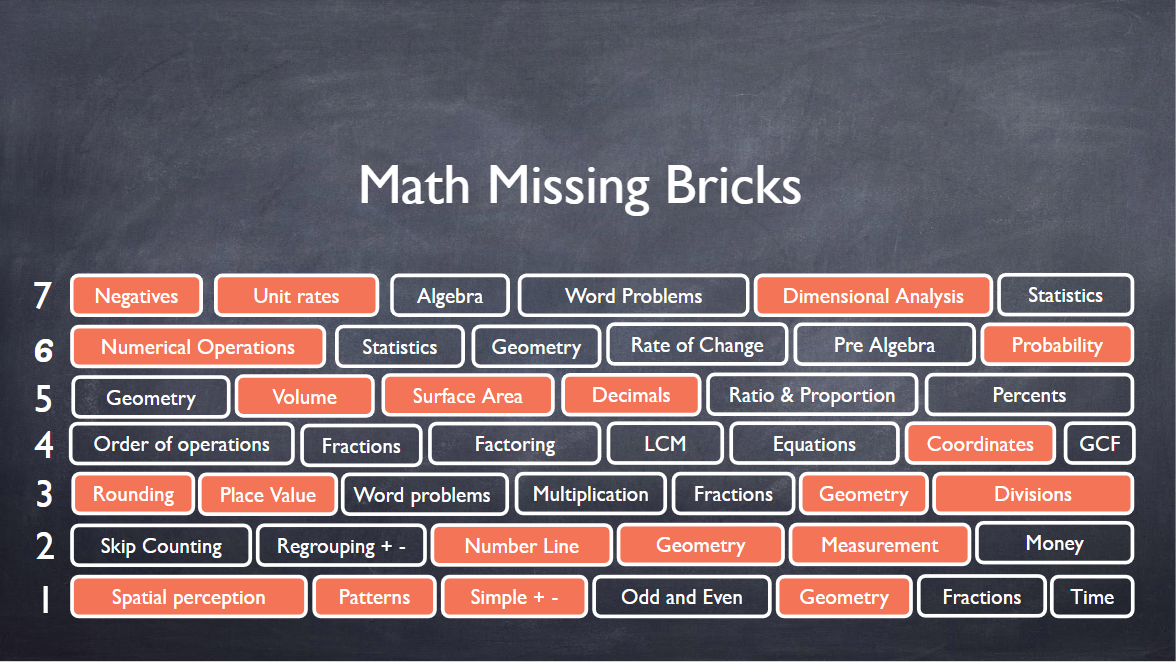
July 21, 2022

July 20, 2022

How to write a perfect 5 Paragraph Essay
How to Write a 5 Paragraph Essay : A Complete Guide
Essay writing can be the bane of many a student’s life.
Gone are the days when many students tried writing in big letters to fill the allotted number of pages with minimal effort quickly.
Now, it’s all constant word count checks and taking a dozen words to say what could be said in three.
Of course, it doesn’t have to be like this. When students have a clear, set structure to follow, essay writing can be a much less painful experience. Indeed, it can even be enjoyable!
In this article, we’ll outline a clear template our students can follow to produce a well-organised essay on practically any topic effectively.
Let’s get started!

THE HAMBURGER ESSAY – THE STUDENT’S FRIEND

The common 5 paragraph essay structure is often referred to as the hamburger essay . And this is a memorable way to communicate the concept to your students.
The hamburger essay structure consists of five paragraphs or layers as follows:
Layer 1 – The Top Bun: The Introduction
The uppermost layer is the introductory paragraph which communicates to the reader the purpose of the essay.
Layers 2,3, & 4 – The Meat Patties: The Body Paragraphs
These are the meat patties of the essay and each paragraph makes an argument in support of the essay’s central contention as expressed in the introduction.
Layer 5 – The Conclusion: The Bottom Bun
The bottommost layer is the conclusion, where the arguments are summed up and the central contention of the essay is restated forcefully one last time. We have a complete guide to writing a conclusion here .
Soon, we’ll take a closer look at each of these parts in turn. But, there is more to an essay than just the writing of it. There are also the prewriting and post writing stages to consider. We will look at all these aspects in this article, but first, let’s examine what our students need to be doing before they even begin to write their essays.
A COMPLETE UNIT ON TEACHING PARAGRAPH WRITING

This complete PARAGRAPH WRITING UNIT takes students from zero to hero over FIVE STRATEGIC LESSONS to improve PARAGRAPH WRITING SKILLS through PROVEN TEACHING STRATEGIES.
THE PREWRITING STAGE – DEFINING THE THESIS STATEMENT, RESEARCH & PLANNING
The thesis statement.
Every essay needs a clear focus. This focus is usually defined in a thesis statement that presents the topic of the essay in a sentence or two. The thesis statement should also include the writer’s stance on that topic.
As this will help guide the direction of the essay, it is essential that our students define their thesis statement before they begin the writing process.
Sometimes during the process of writing, we find out what we think about a given topic. The writing process can act as a kind of reflection on the merits of the various arguments, before finally revealing to us our own opinion. This is writing as a method of discovery.
Usually, though, it is more efficient for students to decide on their opinions prior to beginning to write.
Defining their thesis statement early on not only helps guide the students writing, but helps ensure their research is focused and efficient at the crucial prewriting stage.
Research & Planning
As students begin their research and gather their evidence to support their thesis statement, they should also be encouraged to pay particular attention to the counterarguments they come across.
A well-written essay does not ignore opposing viewpoints, students should be taught to preempt counterarguments where possible so as to strengthen the power of their own arguments. Good research is essential for this.
Not so long ago, research meant hours in dusty libraries being constantly shushed, but with the advent of the internet, there is now a wealth of knowledge right at our fingertips (and the end of a good Wifi connection).
While this has made research a much more convenient process, students need to be reminded of the importance of seeking out reliable sources to support their opinions. In an era of ‘fake news’, this is more important now than ever.
As students gather the information and supporting evidence for their essay, they’ll need to organize it carefully. Graphic organizers are an effective way of doing this, either on a paper printout or by using a premade template on the computer.
It can also be helpful for students to sort their collected information according to where they intend to use it in the five-paragraph outline or layers mentioned above.
Finally, while good research, organization, and planning are essential for producing a well-written essay, it’s important that students are reminded that essay writing is also a creative act.
Students should maintain an open mind when it comes to the writing process. They should allow their thoughts and opinions the room to develop over the course of writing their essay. They should leave the door open for including new thoughts and ideas as the writing progresses.
The Writing Stage: Introduction, Body Paragraphs, & Conclusion
The introduction.
A good introduction paragraph serves a number of important functions. It:
- Grabs the reader’s attention and interest, known as the hook
- Orientates the reader to the essays central argument, the thesis statement
- Outlines briefly the arguments that will be explored in support of the thesis statement.
To become an effective writer, it is important that our students learn the importance of grabbing the reader’s attention, as well as keeping it. Opening with a ‘hook’ or a ‘grabber’ is a great way to achieve this.
There are a number of techniques students can use here. Let’s take a look at some of the more common ones.
- The Surprising Fact – this can intrigue the reader to want to find out more, especially if it challenges some of their existing assumptions on a topic.
- The Quotation – a carefully selected quotation can be a great way to secure the reader’s attention and there are many curated quotation collections freely available online to help get students started.
- The Joke – this opening should be used judiciously as for some topics it may not be an appropriate way to open. In the right context however, humor can be a great way to engage the reader from the outset.
- The Anecdote – anecdotes are a great way to personally connect with the essay’s topic. They are a helpful way of climbing down the ladder of abstraction when exploring more theoretical arguments. They assist the reader in relating universal themes to their own lives.
Practice Activity 1:
To encourage students to develop strong opening paragraphs in their essays, it can be helpful to isolate writing opening paragraphs.
In this activity, provide your students with a list of essay topics and challenge them to write four different opening paragraphs for their essay, one each for The Surprising Fact , The Quotation , The Joke , and The Anecdote as listed above.
When students have completed their four paragraphs, they can then share with each other in groups and discuss which worked best and why.
This activity will help students to remember the different types of opening and how they work. It will also give them a feel for which openings work best for different types of essays.
We’ve already discussed what a thesis statement is and what it is intended to achieve, but where does it fit into the overall shape of the introductory paragraph exactly?
While there are no hard and fast rules here, thesis statements work well towards the end of the introductory paragraph – especially as the paragraph’s final sentence.
Readers are often hardwired to look for the thesis statement there. It connects the arguments that follow in the body paragraphs to the preceding sentences and contextualizes the essay for the reader.
THE BODY PARAGRAPHS
Now we get to the ‘meat’ of our essay. Each of the body paragraphs will explore one of the arguments supporting the thesis statement as laid out in the introduction.
While we are focused on the 5 paragraph essay here, longer essays will usually be constructed in exactly the same manner, they’ll just include more body paragraphs to cover the extra level of detail.
Generally, each body paragraph will open by stating the argument, with subsequent sentences supporting that argument by providing evidence along with some further explanation. Finally, a statement or phrase will help transition to the next paragraph.
The PEEL Paragraph Writing Process
The acronym PEEL can be a very useful tool to help students to understand how to organize each of their body paragraphs.
P oint : start the paragraph by expressing the central argument
E vidence : support the central argument of the paragraph by providing evidence or reasons. Evidence may come in many forms including facts and statistics, quotations from a text or other authority, reference to historical events etc.
E xplanation : explain how the evidence provided supports the paragraph’s central argument.
L ink : provide a transition into the next paragraph by linking this argument and the central thesis to the next point to be made.

Practice Activity 2:
Just as students isolated the opening to their introductory paragraph for practice purposes, in this activity they’ll isolate a single argument on a chosen essay topic.
When they have chosen a topic and selected a single argument related to that topic, they can begin to write one body paragraph using the PEEL structure outlined above.
This activity works well when several students write on the same argument. When each has completed their paragraphs, they can then compare the results with each other.
It can be a fascinating experiment that allows the students to see just how diverse different treatments of the same argument using the same PEEL formula can be – there is freedom within the discipline of the structure!
THE CONCLUSION
The purpose of the conclusion is to close the circle of the essay. It is a chance for the writer to restate the thesis statement, summarize the main arguments, and tie up any loose ends as the writer drives home their point one last time.
At this stage of the game, no new arguments should be introduced. However, students should revisit the previous arguments made in the body paragraphs and it is acceptable to offer up a new insight or two on these.
The student should take care here to make sure they leave no doubt in the reader’s mind that the essay question is fully answered. One useful way of doing this is by incorporating words and phrases from the essay question into the conclusion itself.
To help students grasp the underlying structure of a concluding paragraph, the following sequential structure is useful to keep in mind:
- Starts with a closing phrase such as In conclusion , There is no doubt , Finally etc
- Restates the main thesis statement
- Summarizes the main point of each of the body paragraphs
- Leaves the reader with something to think about.
Practice Activity 3:
Again, here we will isolate the concluding paragraph for focused practice.
Students select a topic they know well, decide what they think about that topic, write down a few key arguments, and then begin writing a concluding paragraph to an essay on that topic.
Students should use the template above to structure that material.
You could also include an element of peer assessment here by having students swap their paragraphs with each other, before offering each other feedback.
The Post Writing Stage: Editing & Proofreading YOUR 5 paragraph ESSAY
The final stage of writing a five-paragraph essay is perhaps the least glamorous of an unglamorous process, but no less essential for it – the editing and proofreading.
Often, our students overlook this stage. After completing the process of research, planning, and writing their five-paragraph essay, they let themselves down at this final, crucial stage.
Frequently, students fail to adequately edit and proofread their work not just because of laziness, but because they are unsure of exactly what this process entails.
To avoid this, ensure students understand that editing and proofreading involve reading through and correcting mistakes in the following areas one after the other:
- Text Organisation: title, headings, layout etc
- Sentence Structure: coherence, grammar , sentence variety etc
- Word Choice: suitable word choices, avoid repetition etc
- Spelling and Punctuation: accuracy in both areas.
Practice Activity 4:
Once students have completed their essays, appoint each a partner to work with and each then edits and proofreads the other person’s work.
Sometimes students struggle to gain the necessary distance from their own work to adequately edit and proofread it, this exercise overcomes that issue while giving them an opportunity to gain some valuable editing and proofreading experience that will benefit them in future.
CLOSING THE CIRCLE
So, there you have it – how to write a five-paragraph essay from start to finish. As with anything, the more practice students get, the quicker they will improve.
But, bear in mind too that writing essays is hard work and you don’t want to put students off.
The best way to provide opportunities for students to develop the various skills related to essay writing is to isolate them in the manner apparent in the activities described above.
This way, students can soon sharpen up their skills, without learning to dread the word ‘essay’ itself!

Teaching Resources
Use our resources and tools to improve your student’s writing skills through proven teaching strategies.

Five Paragraph Essay exampleS (Student Writing Samples)
Below are a collection of student writing samples of 5 paragraph essays. Click on the image to enlarge and explore them in greater detail. Please take a moment to both read the 5 paragraph essay in detail but also the teacher and student guides which highlight some of the key elements of this structured model of essay writing here.
Please understand these student writing samples are not intended to be perfect examples for each age or grade level but a piece of writing for students and teachers to explore together to critically analyze to improve student writing skills and deepen their understanding of 5 paragraph essay writing.
We would recommend reading the example either a year above and below, as well as the grade you are currently working with to gain a broader appreciation of this text type.

5 PARAGRAPH ESSAY VIDEO TUTORIALS

The Five Steps of Writing an Essay
Mastering these steps will make your words more compelling
- Tips For Adult Students
- Getting Your Ged
:max_bytes(150000):strip_icc():format(webp)/Deb-Nov2015-5895870e3df78caebc88766f.jpg)
- B.A., English, St. Olaf College
Knowing how to write an essay is a skill that you can use throughout your life. The ability to organize ideas that you use in constructing an essay will help you write business letters, company memos, and marketing materials for your clubs and organizations.
Anything you write will benefit from learning these simple parts of an essay:
- Purpose and Thesis
Introduction
Body of information.
Here are five steps to make it happen:
Purpose/Main Idea
Echo / Cultura / Getty Images
Before you can start writing, you must have an idea to write about. If you haven't been assigned a topic, it's easier than you might think to come up with one of your own.
Your best essays will be about things that light your fire. What do you feel passionate about? What topics do you find yourself arguing for or against? Choose the side of the topic you are "for" rather than "against" and your essay will be stronger.
Do you love gardening? Sports? Photography? Volunteering? Are you an advocate for children? Domestic peace? The hungry or homeless? These are clues to your best essays.
Put your idea into a single sentence. This is your thesis statement , your main idea.
STOCK4B-RF / Getty Images
Choose a title for your essay that expresses your primary idea. The strongest titles will include a verb. Take a look at any newspaper and you'll see that every title has a verb.
Your title should make someone want to read what you have to say. Make it provocative.
Here are a few ideas:
- America Needs Better Health Care Now
- The Use of the Mentor Archetype in _____
- Who Is the She-Conomy?
- Why DJ Is the Queen of Pedicures
- Melanoma: Is It or Isn't It?
- How to Achieve Natural Balance in Your Garden
- Expect to Be Changed by Reading _____
Some people will tell you to wait until you have finished writing to choose a title. Other people find that writing a title helps them stay focused. You can always review your title when you've finished the essay to ensure that it's as effective as it can be.
Hero-Images / Getty Images
Your introduction is one short paragraph, just a sentence or two, that states your thesis (your main idea) and introduces your reader to your topic. After your title, this is your next best chance to hook your reader. Here are some examples:
- Women are the chief buyers in 80 percent of America's households. If you're not marketing to them, you should be.
- Take another look at that spot on your arm. Is the shape irregular? Is it multicolored? You could have melanoma. Know the signs.
- Those tiny wasps flying around the blossoms in your garden can't sting you. Their stingers have evolved into egg-laying devices. The wasps, busying finding a place to lay their eggs, are participating in the balance of nature.
Vincent Hazat / PhotoAlto Agency RF Collections / Getty Images
The body of your essay is where you develop your story or argument. Once you have finished your research and produced several pages of notes, go through them with a highlighter and mark the most important ideas, the key points.
Choose the top three ideas and write each one at the top of a clean page. Now go through your notes again and pull out supporting ideas for each key point. You don't need a lot, just two or three for each one.
Write a paragraph about each of these key points, using the information you've pulled from your notes. If you don't have enough for one, you might need a stronger key point. Do more research to support your point of view. It's always better to have too many sources than too few.
Anna Bryukhanova/E Plus / Getty Images
You've almost finished. The last paragraph of your essay is your conclusion. It, too, can be short, and it must tie back to your introduction.
In your introduction, you stated the reason for your paper. In your conclusion, you should summarize how your key points support your thesis. Here's an example:
- By observing the balance of nature in her gardens, listening to lectures, and reading everything she can get her hands on about insects and native plants, Lucinda has grown passionate about natural balance. "It's easy to get passionate if you just take time to look," she says.
If you're still worried about your essay after trying on your own, consider hiring an essay editing service. Reputable services will edit your work, not rewrite it. Choose carefully. One service to consider is Essay Edge .
Good luck! The next essay will be easier.
- How to Structure an Essay
- How To Write an Essay
- Tips for Writing an Art History Paper
- How to Write a Research Paper That Earns an A
- What Is Expository Writing?
- 6 Steps to Writing the Perfect Personal Essay
- Development in Composition: Building an Essay
- How to Write a Great College Application Essay Title
- The Ultimate Guide to the 5-Paragraph Essay
- Tips on How to Write an Argumentative Essay
- How to Write a Good Thesis Statement
- How to Write a Great Essay for the TOEFL or TOEIC
- How to Write a Persuasive Essay
- Write an Attention-Grabbing Opening Sentence for an Essay
- How To Write a Top-Scoring ACT Essay for the Enhanced Writing Test
- How to Start a Book Report

Reading & Math for K-5
- Kindergarten
- Learning numbers
- Comparing numbers
- Place Value
- Roman numerals
- Subtraction
- Multiplication
- Order of operations
- Drills & practice
- Measurement
- Factoring & prime factors
- Proportions
- Shape & geometry
- Data & graphing
- Word problems
- Children's stories
- Leveled Stories
- Context clues
- Cause & effect
- Compare & contrast
- Fact vs. fiction
- Fact vs. opinion
- Main idea & details
- Story elements
- Conclusions & inferences
- Sounds & phonics
- Words & vocabulary
- Reading comprehension
- Early writing
- Numbers & counting
- Simple math
- Social skills
- Other activities
- Dolch sight words
- Fry sight words
- Multiple meaning words
- Prefixes & suffixes
- Vocabulary cards
- Other parts of speech
- Punctuation
- Capitalization
- Narrative writing
- Opinion writing
- Informative writing
- Cursive alphabet
- Cursive letters
- Cursive letter joins
- Cursive words
- Cursive sentences
- Cursive passages
- Grammar & Writing
Breadcrumbs
Writing strong introductions
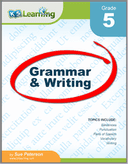
Download & Print Only $6.89

Hooks, topics and reasons
Students plan and write an introductory paragraph including a hook, a topic sentence and a brief summary of 3 reasons that would be expanded upon in a full essay.

These worksheets are available to members only.
Join K5 to save time, skip ads and access more content. Learn More
What is K5?
K5 Learning offers free worksheets , flashcards and inexpensive workbooks for kids in kindergarten to grade 5. Become a member to access additional content and skip ads.
Our members helped us give away millions of worksheets last year.
We provide free educational materials to parents and teachers in over 100 countries. If you can, please consider purchasing a membership ($24/year) to support our efforts.
Members skip ads and access exclusive features.
Learn about member benefits
This content is available to members only.
- Forgot Password?
- PRO Courses Guides New Tech Help Pro Expert Videos About wikiHow Pro Upgrade Sign In
- EDIT Edit this Article
- EXPLORE Tech Help Pro About Us Random Article Quizzes Request a New Article Community Dashboard This Or That Game Popular Categories Arts and Entertainment Artwork Books Movies Computers and Electronics Computers Phone Skills Technology Hacks Health Men's Health Mental Health Women's Health Relationships Dating Love Relationship Issues Hobbies and Crafts Crafts Drawing Games Education & Communication Communication Skills Personal Development Studying Personal Care and Style Fashion Hair Care Personal Hygiene Youth Personal Care School Stuff Dating All Categories Arts and Entertainment Finance and Business Home and Garden Relationship Quizzes Cars & Other Vehicles Food and Entertaining Personal Care and Style Sports and Fitness Computers and Electronics Health Pets and Animals Travel Education & Communication Hobbies and Crafts Philosophy and Religion Work World Family Life Holidays and Traditions Relationships Youth
- Browse Articles
- Learn Something New
- Quizzes Hot
- This Or That Game
- Train Your Brain
- Explore More
- Support wikiHow
- About wikiHow
- Log in / Sign up
- Education and Communications
- College University and Postgraduate
- Academic Writing
How to Write a Five Paragraph Essay
Last Updated: April 4, 2024 Fact Checked
This article was co-authored by Jake Adams and by wikiHow staff writer, Danielle Blinka, MA, MPA . Jake Adams is an academic tutor and the owner of Simplifi EDU, a Santa Monica, California based online tutoring business offering learning resources and online tutors for academic subjects K-College, SAT & ACT prep, and college admissions applications. With over 14 years of professional tutoring experience, Jake is dedicated to providing his clients the very best online tutoring experience and access to a network of excellent undergraduate and graduate-level tutors from top colleges all over the nation. Jake holds a BS in International Business and Marketing from Pepperdine University. There are 8 references cited in this article, which can be found at the bottom of the page. This article has been fact-checked, ensuring the accuracy of any cited facts and confirming the authority of its sources. This article has been viewed 524,704 times.
Five paragraph essays are a common assignment throughout your school career, especially in high school and college. Since any subject can include a five paragraph essay, you’ll want to be good at writing them. Luckily, five-paragraph essays are really easy to write if you know the expected format and give yourself the time you need to write it. To write your five paragraph essay, draft your introduction, develop three body paragraphs, write your conclusion, and revise and edit your essay.
Drafting Your Introduction

- For example, you could phrase your hook like this: Nature’s life cycle is often used as a metaphor to convey ideas about the passage of life.
- If you are writing a persuasive essay, don’t include your stance in your hook.
- Don’t say “In this essay” or “I am going to show.” Instead, use the “show, don’t tell” technique using descriptive language.
- It’s often easiest to come up with your hook after you write the rest of your essay. If you’re struggling to come up with one, use a basic placeholder and then create a better hook when you revise your essay.

- Don’t reveal your main points yet.
- For example, you could say something like this: While spring compares with birth, summer can symbolize maturity, with fall and winter showing a descent toward death.

- This sentence depends on what type of paper you’re writing. If it’s an argumentative paper, introduce both sides of the argument. In an informative paper, mention the central idea and focus.
- As an example, you could narrow your topic like this: Writers often use nature metaphors in their work to show themes about life, such as the blossoming of youth.

- For example, your thesis could read like this: In the poem “Raspberries,” the author shows youth through the ripening berries, summer blossoming, and blushing color of the fruit.
- Each of the three examples provided in the thesis will become the topic of a body paragraph. For the example thesis, you would have body paragraphs about ripening berries, summer blossoming, and the blushing color of the fruit.
Developing Three Body Paragraphs

- You should include three body paragraphs, one for each supporting point.

- Your topic sentence is like a mini-thesis for just that paragraph.
- Use a quote related to your thesis and analyze it in the body paragraph. If you use a topic sentence, put the quote next.
- For example, your topic sentence could look like this: Ripening berries show youth in the poem “Raspberries” by reaching maturity and becoming ready for picking.

- Each paragraph should contain two to three examples or pieces of evidence.
- If you use research, cite your sources in the appropriate format that your instructor specifies.

- Include two to three sentences of commentary for each example or piece of evidence.
- Depending on the type of evidence or examples, it’s often best to alternate your evidence and commentary throughout the paragraph. For example, provide one example, then provide the commentary.

- For example, you could wrap up your paragraph like this: As the girl plucks the ripe raspberries from the bush and eats them, her actions represent her own youth and readiness to be “plucked” by someone.
Drafting Your Conclusion

- For example, you could restate your thesis like this: The poem “Raspberries” provides an allegorical representation of youth through a metaphor of ripening berries, summer blossoming, and blushing color of the fruit.
- If you're a beginning writer, it's okay to start your conclusion with "In conclusion." However, if you're an advanced writer, avoid starting your conclusion with statements like “In conclusion,” “To conclude,” or “In the end.”

- Use an authoritative tone as you restate your arguments so that your reader walks away knowing that you are correct.

- Include a call to action.
- Provide a warning about what could happen if your stance is ignored.
- Create an image in the reader’s mind.
- Include a quote.
- Make a universal statement about life.
Revising and Editing Your Essay

- Always reread your sentence to make sure that the word processor is suggesting the right word. If you’ve misspelled a word that is similar to another word, then it’s possible that your spell check could suggest the wrong spelling, such as “then” instead of “than.”

- Look for errors that your spell checker missed.
- If you can, ask someone else to proofread your paper. They will usually spot errors that you overlooked.

- Combine choppy sentences.
- Breakup long, convoluted sentences into shorter sentences.
- Rewrite fragments and run-on sentences.

- If you have cited sources, make sure that you include a reference page in the style chosen by your instructor.

Expert Q&A

- Never plagiarize an essay, which means copying someone’s work or ideas without giving them credit. Your teacher will deny you credit for the essay, and you may also get a discipline consequence. Thanks Helpful 0 Not Helpful 1

You Might Also Like

- ↑ Jake Adams. Academic Tutor & Test Prep Specialist. Expert Interview. 20 May 2020.
- ↑ https://www.grammarly.com/blog/five-paragraph-essay/
- ↑ https://writingcenter.unc.edu/tips-and-tools/college-writing/
- ↑ https://www.bucks.edu/media/bcccmedialibrary/pdf/FiveParagraphEssayOutlineJuly08_000.pdf
- ↑ https://www.ncbi.nlm.nih.gov/pmc/articles/PMC4789530/
- ↑ https://writingcenter.fas.harvard.edu/pages/ending-essay-conclusions
- ↑ https://owl.purdue.edu/owl/general_writing/the_writing_process/proofreading/proofreading_suggestions.html
- ↑ https://owl.purdue.edu/owl/general_writing/the_writing_process/proofreading/steps_for_revising.html
About This Article

To write a five paragraph essay, start with an introductory paragraph that includes a hook to capture your audience’s attention, and a thesis that explains the main point you’re trying to make. Then, use the next 3 paragraphs to explain 3 separate points that support your thesis. As you explain each point, use evidence from your research or examples in the text you’re discussing. Finally, conclude your essay with a paragraph summing up the points you’ve made and telling the reader how those points support your thesis. For tips on how to revise your essay to improve the flow and formatting, read on! Did this summary help you? Yes No
- Send fan mail to authors
Reader Success Stories
Mohamed Abdou
Nov 3, 2017
Did this article help you?

Suzanne Carlson
Jul 20, 2020
Hunter Fleming
Feb 16, 2017
Oct 6, 2016
Dave Seville
Mar 24, 2017

Featured Articles

Trending Articles

Watch Articles

- Terms of Use
- Privacy Policy
- Do Not Sell or Share My Info
- Not Selling Info
Get all the best how-tos!
Sign up for wikiHow's weekly email newsletter
Purdue Online Writing Lab Purdue OWL® College of Liberal Arts
Welcome to the Purdue Online Writing Lab

Welcome to the Purdue OWL
This page is brought to you by the OWL at Purdue University. When printing this page, you must include the entire legal notice.
Copyright ©1995-2018 by The Writing Lab & The OWL at Purdue and Purdue University. All rights reserved. This material may not be published, reproduced, broadcast, rewritten, or redistributed without permission. Use of this site constitutes acceptance of our terms and conditions of fair use.
The Online Writing Lab at Purdue University houses writing resources and instructional material, and we provide these as a free service of the Writing Lab at Purdue. Students, members of the community, and users worldwide will find information to assist with many writing projects. Teachers and trainers may use this material for in-class and out-of-class instruction.
The Purdue On-Campus Writing Lab and Purdue Online Writing Lab assist clients in their development as writers—no matter what their skill level—with on-campus consultations, online participation, and community engagement. The Purdue Writing Lab serves the Purdue, West Lafayette, campus and coordinates with local literacy initiatives. The Purdue OWL offers global support through online reference materials and services.
A Message From the Assistant Director of Content Development
The Purdue OWL® is committed to supporting students, instructors, and writers by offering a wide range of resources that are developed and revised with them in mind. To do this, the OWL team is always exploring possibilties for a better design, allowing accessibility and user experience to guide our process. As the OWL undergoes some changes, we welcome your feedback and suggestions by email at any time.
Please don't hesitate to contact us via our contact page if you have any questions or comments.
All the best,
Social Media
Facebook twitter.
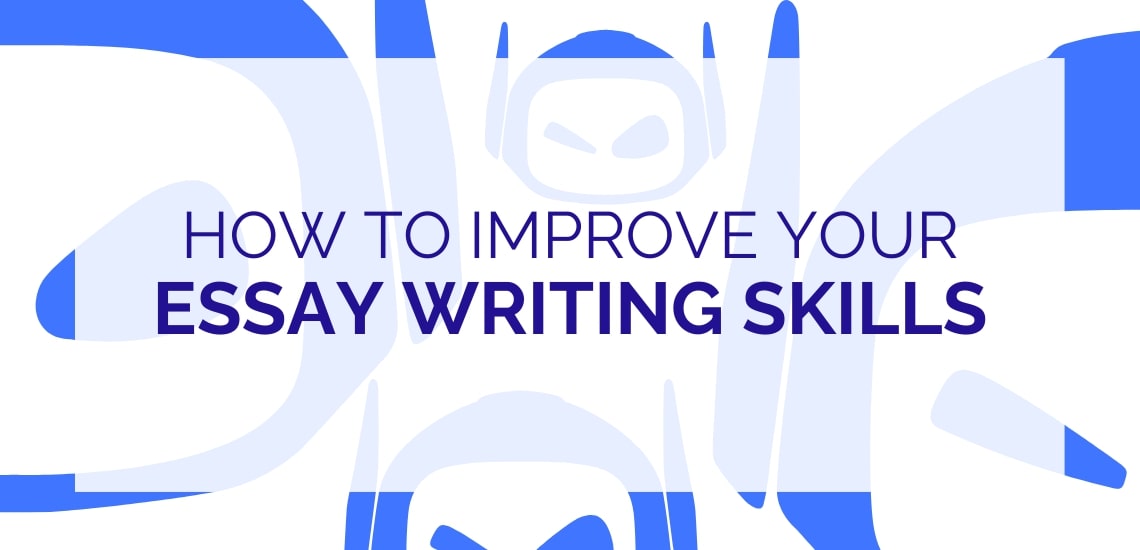
How to Improve Your Essay Writing Skills in 10 Simple Steps
- Smodin Editorial Team
- Updated: May 5, 2024
What makes an A essay different from a B essay? What makes one essay stand out among countless submissions while others barely make the grade?
The answer lies in both the content and the execution of your writing. Strong content that is poorly executed can lead to disappointing results, just as weak content cannot be saved by writing style alone.
A strong essay needs to be balanced. The writing should be informative and exciting but also fun to read. At the same time, your grammar, syntax, and punctuation should be on point.
If you’re struggling to make the grade and are unsure what you’re doing wrong, this article will cover ten basic strategies for improving your writing skills.
With a bit of understanding and a steady commitment to improving your craft, you should see a noticeable increase in your essay grades.
These strategies will help refine your writing style and structure while enhancing your analytical thinking and argumentative skills. We’ll also discuss some AI tools you can use starting today to make the essay writing process more fun and manageable.
1. Read a Lot
To truly master the art of writing, you must read as much as you can. To the best of your ability, immerse yourself in various texts and read across different genres and disciplines.
One of the best things you can do in essay writing is study published essays and periodicals to better understand how accomplished writers develop their arguments and maintain flow.
Of course, reading is a time-consuming activity. If you want to expand your knowledge without spending hours at a time in the library, consider using Smodin AI to help.
Smodin’s AI Summarizer can help you take long pieces of text and create an extractive or abstractive summary. This way, you can read a portion of the text and use AI to grasp the main points and key arguments without dedicating too much time to each piece.
Using this approach, you can cover a broader range of materials in a shorter time, particularly useful if you’re juggling multiple assignments or subjects during midterms or finals week.
2. Understand the Topic
A solid understanding of your essay topic is crucial to producing an engaging and insightful piece of writing. One of the worst things you can do as a student is to submit a paper without thoroughly researching and understanding the topic.
In other words, read the instructions before writing a single word. Invest however much time you need in researching and gathering relevant information.
Don’t rush the process, and take the time to build a strong foundation for your arguments. Study the counterarguments and ensure that your thesis is factually accurate and thoroughly thought-out.
That said, if you’re sitting at your desk, struggling to figure out where to start, or need help comprehending the topic, Smodin’s AI Chat can help you gather your thoughts.
The chat can help you understand complex topics using real-time Google Insights and provide instant access to a wealth of information with a single click.
3. Outline Your Essay
Even the best writers outline their writing before they begin. Creating an outline is crucial to organizing your thoughts and structuring your essay so it flows logically and cohesively.
When writing an essay, your topic will often take on new dimensions as you delve deeper into your research. Sometimes, your essay ends far off course and entirely different from what you envisioned.
An evolving outline can help you manage these ideas and ensure they are woven into your essay in a way that is meaningful and makes sense.
Any piece of writing needs a roadmap, whether it’s essays, articles, short stories, novels, or nonfiction books. Your ideas need to progress logically from one point to another so that they are persuasive and easy for your reader to follow.
Remember, effective time management is one of the secrets to writing an effective essay. That’s why it’s essential to use AI tools like Smodin to optimize your outlining process.
4. Master the Basics
A strong command of grammar, syntax, and punctuation is fundamental to writing an A-level essay. While most teachers and professors will not deduct points for an occasional misspelling or comma splice, too many mistakes will leave a negative impression on your reader.
The good news is that mastering the basics of writing has never been easier, thanks to the rise of AI. Do your best to practice the basics of good writing using ordinary resources like grammar guides and books, then use AI to enhance your knowledge.
In this area, Smodin has several tools that can help. The AI Rewriter can help you rewrite or completely recreate a piece of text to optimize the content so it is polished and easy to read.
You can also use the AI Chat feature to ask any question you like about grammar rules or stylistic choices, ensuring that you understand the fundamental principles of good writing.
5. Nail the Intro
The introduction of your essay sets the tone and hooks the reader. It also helps you make a strong impression and stand out among your peers.
A compelling intro should start with a strong first sentence that piques curiosity and leads the reader to the second sentence. That second sentence should lead the reader directly to the third, and so on.
Always do your best to think of a solid opening statement or pose a thought-provoking question. Remember, your essay is just one of many essays the teacher or professor must read, so you must do everything possible to stand out.
You want a clear and concise thesis that sets up the arguments you will develop throughout the body of your essay. Smodin’s AI Essay Writer can help you craft essays with compelling titles and opening paragraphs.
If you want to go the extra mile, consider trying the “Supercharge” option to tap into the power of a much more advanced and sophisticated AI model to take your writing to the next level.
6. Use the Active Voice
Generally, the active voice is more engaging and easy to read than the passive voice. Active voice constructions are more direct and energetic. They keep the reader engaged and make statements that are easier to visualize.
For example, compare the active sentence “The scientist conducted the experiment” with the passive “The experiment was conducted by the researcher.”
The active voice allows you to clearly identify who is taking action. This helps make your writing more assertive and easy to understand.
However, there are situations where the passive voice is appropriate or even necessary. For instance, if the person taking action is unknown, irrelevant, or obvious from the context, the passive voice might be the better choice.
For example, in scientific or formal reports, the passive voice is often used to create an impersonal tone and to emphasize the action rather than the person.
In most cases, you should use the active voice to make your arguments more engaging and your prose easier to follow.
7. Avoid Repetition
If you’ve ever tried to “word stuff” an essay to get to a specific word count, you know how easy it can be to repeat yourself accidentally. To keep your essay engaging, always do your best to avoid unnecessary repetition of words or ideas.
Never use the same word too often, especially in the same paragraph. Varying your language and sentence structure can help keep the reader engaged and create a pleasant cadence for your essay.
Always avoid rehashing the same ideas twice unless necessary to your thesis or argument. When in doubt, use Smodin’s Essay Writer to help structure your essays with a clear flow and easy-to-understand introductions and conclusions.
8. Get Feedback
Receiving feedback is one of the most effective ways to improve your writing. Of course, your teacher’s or professor’s feedback matters the most, but what if you want feedback before the final submission?
Seek constructive criticism from peers or tutors who can look at your writing and give you feedback to help you improve your writing. Being able to seek out and incorporate feedback is one of the most vital skills a student can have.
Also, consider using an AI tool like Smodin that can draw upon hundreds of thousands of published and peer-reviewed academic articles as a basis of comparison. By tapping into the unlimited power of AI, you can easily create essays that match college-level writing standards.
9. Organize Your References
Managing and organizing references can become overwhelming during the research phase of writing an essay.
It’s crucial to keep track of all the sources you consult to maintain academic integrity and avoid plagiarism. This is where tools like Smodin’s Research Paper Generator come into play.
Smodin’s Automatic References tool utilizes AI-powered algorithms to generate accurate citations. It pulls information from reliable databases like Google and Google Scholar, ensuring each reference is precise and meets academic standards.
This feature is a time-saver and a crucial component for any student who wants to ensure their work is appropriately credited and free of plagiarism concerns.
This tool streamlines the process of citation creation. The Automatic References feature formats each reference correctly according to your chosen style guide, whether it’s APA, MLA, Chicago, or another academic citation format.
This allows you to focus more on the content of your essay rather than the tedious task of manual citation. It’s like having a personal assistant at the click of a button.
10. Revise, Revise, Revise
The single best thing you can do to improve your writing is to get into a habit of constant revision. Try to write your essay as far in advance so that you can let it sit for a while and revisit it with fresh eyes.
You may be surprised how many areas of improvement become apparent after taking a short break. Allowing your writing to breathe after the initial draft can dramatically enhance its quality.
The three main things you want to look for are ways to improve clarity, strengthen your argument, and refine your language.
Of course, Smodin’s Rewriter Tool can help you do just that. Using this tool, you can easily see and improve sections that need rephrasing. Use this technology alongside your own manual refinements to create a tone and style that aligns with your voice and creates a unique style.
Then, once you’re 99% done and happy with your essay, run it through the Plagiarism and AI Content Detector to ensure its complete academic integrity.
Ultimately, your ability to improve your essay writing skills will depend on your level of dedication. Spend as much time as you can mastering the above techniques and consistently practice.
Remember, AI tools like Smodin have made essay writing more accessible than ever before. If you need help with essays and consistently bring home B, C, or even D-level papers, Smodin’s array of AI tools is what you need to take your writing to the next level-
- AI tutoring for students
- AI content detection
- Plagiarism checker
- Essay, research paper, and article writing features
- Text summarizer
- Homework solver
When you sign up for Smodin, all this and more comes standard. If you’re ready to get started, click here to try it!

- Mar 24, 2021
Essays in 6th Grade: A Basic Format that Elevates the Standard 5-Paragraph Structure

6th grade is such a funny year. Funny haha and funny weird. Student writing levels are all over the map. You will have students coming to you writing on a very elementary level, still needing loads of help with grammar and paragraph formation. Then, you will have students ready to write critique pieces and analyses. How do you navigate this? Read to find out more!
Give Them a Format...to Start
I've learned that 6th graders still need format . They still need structure. They still need checklists. As much as I loathe limiting them in this way, I think it is very reassuring to them. That's not to say you can't tweak for the strong writers, but I do still feel they need it.
For my students in particular, I like to let them dabble in looser formats of non-fiction writing in other ways. They do book reviews , a debate , podcasting , etc. They are offered choices in reading responses to non-fiction reading and analysis, too. My classes actually write digital eBooks, too. But on the whole, they are expected to write two essays with a very similar format twice a year.
Bye-Bye 5-Paragraph Essay
Alright, so this is kind of not totally true. My students do end up writing 5 paragraphs, but that typical structure we all commonly know, I navigate away from. I think it's a fine format, but as they get into middle school they are expected to compare a LOT more and not focus on one specific topic . They are expected to follow through on a thread, a claim, a theme, an idea and how it is shown in various sources. And this is super new for them, analyzing various sources on the same concept. They really need a structure for this.
So, the typical essay, before they get to me, goes like this, and it is a good precursor:
Introduction that states your thesis and 3 major reasons to support your claim.
Conclusion that looks a whole lot like the introduction.
This format does not allow analysis of multiple sources and if you throw in other sources, it gets messy. Instead, I gear my students to focus on each source separately, then comparing them all.
The Format that Works (Research and Literary Analysis)
First of all, it's important to know what essays I actually do with my kiddos. I do a research unit. This changes almost every year, but typically they choose some kind of topic, I group them based on their topic choice. First, they do research (non-fiction skills) using a book, article, and video. They then use those sources to write an essay on a claim they make based on their topic. Later, they make eBooks in groups based on their topic.
The other essay I do is Literary Analysis . This follows a dystopian unit . They read a dystopian book in book clubs. Then, I have them choose from a short list of short stories that are dystopian. Lastly, we watch the movie The Truman Show . (This year I had them watch "The Scarecrow" on YouTube since we were hybrid due to the pandemic). They then determine a theme that is true for all three sources and write an essay based on that theme.
This essay format works for both of these essays. So here it goes!

Introductory and Conclusion Statements
In a traditional essay, students have to write a hook, their claim/thesis, and essentially ANOTHER three sentences that state what their essays will be about. In my opinion, all of this is completely unnecessary. How many times do you read introductions in books? Okay, real avid readers do, but in reality many people don't. So for these, I tell my students to get right to the point .
Here's what should be in their introductory and conclusion statements:
A statement that introduces the topic. (This is a hook of some kind. I sometimes tell them to start it with "in our world..." or "in our lives..." and something that relates to their topic. Or just starting it with their topic and explaining what it is.)
The claim/thesis.
A statement that references there are differences and similarities in the sources. (For example: "[Title of sources] support this claim in different and similar ways." That's it.)
This all ends up being 2-3 sentences.
Topic Sentences
I have my students start their essay prep with topic sentences. This helps them get a sense of where their essays will go.
The big thing to understand here is how the paragraphs are set up .
Body #1 : Focus on source #1 and how it shows claim/thesis.
Body #2 : Focus on source #2 and how it shows claim/thesis.
Body #3 : Focus on source #3 and how it shows claim/thesis.
Body #4 : Focus on how ALL SOURCES show the claim/thesis in the same way.
So they start with creating topic sentences for those paragraphs. Each topic sentence is set up like this. The last topic sentence would start with "all sources..." instead of "source title".:

Body Paragraph Format
In the picture you see below, I have specific colors for specific aspects of body paragraphs. ALL body paragraphs follow this format in that exact sequence/order. I will be completely honest, I don't give them a ton of wiggle room since this is pretty new to them. However, my stronger writers dabble in mixing evidence stems and elaboration stems around.

Their paragraph starts with the topic sentence they already prepared. From there, the next sentence begins with an evidence stem . Here are a few examples of evidence stems:
According to the text,
The author states,
In [title],
Right after the evidence stem, in the same sentence, they add their text detail to support their topic sentence. I encourage them to quote exactly from the text for most text details. They can paraphrase, too, but should really try to get exact lines.
In regards to quoting, I also mention to them not to quote plop . I made this up. I plan on making a product for this at some point. A quote plop is bad . It's when students take a line from the text and just plop it in their essay. I show them how to break up the quote from the text with their own words.
So, a first sentence may look like this: According to the text [evidence stem, highlighted green] , when Luke was hiding due to being a third child, "they took the woods away" , [text detail with context, a.k.a. not just plopping the quote in the sentence, highlighted yellow].
Directly after that sentence should be an elaboration stem with an elaboration explaining how the text detail shows their claim/thesis. Students highlight this entire sentence in blue and their claim within it dark blue. Here are some elaboration stems:
This proves [claim] because...
This shows [claim] because ...
After that they do the same process two more times; two more text details with elaborations. Lastly they do a closing sentence .

Comparison Paragraph: This is set up almost exactly the same, except the focus is on how ALL the sources show the claim in the same way. They then provide a NEW text detail from each source to prove how the claim is being shown similarly in each.

Once all their body paragraphs are written, I have them go review their introductory and conclusion statements, put everything into a final draft and leave the highlights in the essay . This helps them visualize all the components and helps me grade!
For revision, the focus is on not quote plopping, being sure their details support their thesis, changing up the wording of claims/theses, and rearranging for strong writers.
Bottom Line
While this is very limiting for some, it is super helpful for struggling writers. Having that checklist and having the highlights helps students visualize what they need to compare sources in an essay format.
I'd say it'd be great to introduce this in 6th and by 8th, they can certainly make these more interpretive, creative, and unique.
You can find a lot more detail about this in the product below . What you see here is only a taste. This contains a full sample essay, checklists, tips, and more. You can also edit it to meet your needs.

************
Want a custom bundle from me click below.

Teachers Pay Teachers Store
Recent Posts
Spring Things! Fun with Poetry and Figurative Language
Text Structure Explanatory Writing: Creating a Dodecahedron
Why I Don't Do a Daily Reading Log: What I Do Instead
Really interesting - thank you!!
This exactly the kind of thing I've been looking for, and even better! I love your approach and it's so well explained. I couldn't disagree more with any of the negative feedback to this article. I think it's perfect for my style of teaching and my standard of writing. Most of all, the way you explained this and broke it down into small steps will make it so achievable for even lagging students to develop great writing skills and feel confident in the process! You nailed it. Thank you so much!
I read all the essay writing format instructions. All the points are useful for any kind of essay writing. But at the age of high-level essay writing learners need to be essay writer experts like the 6 Dollars Essay Website , ready to do professional essay writing for any essay grade.
This is beyond me and I teach HS English. Where does this lady teach, at Princeton? I do not know any 6th grader that does this or would understand this. I see why so many of our young people have become disinterested in the learning process. I also see why so many teachers quit. The profession is stale, boring, and antiquated. This article was not fun to read and I'm thinking this new 5 paragraph writing style would be a drag for the average ela teacher to teach.
. In the blog post, I mention the various types of writing I do with students. I also have other blog posts that discuss these other formats. This is not the end all be all. In my over a decade experience with teaching writing, having a structure helps struggling writers. This is not a writing style. This a format for one type of writing. As teachers, we should be offering all types of formats, especially with younger writers who are still learning how to write.

Literary Analysis Essay
Literary analysis essay generator.

Literary analysis essays offer a deeper understanding and interpretation of literary works, allowing readers to delve into the intricacies of a story, poem, or novel. Whether you’re a student or a literature enthusiast, analyzing literature can be a rewarding experience. In this article, we will explore a collection of 30+ literary analysis essay examples available in Word, Google Docs, and PDF formats. We will also discuss essential elements such as analysis paper outlines , literary devices, short story analysis, literature reviews, theses, analogies, book reviews, context, and conclusions.
1. Literary Analysis Essay Outline Example
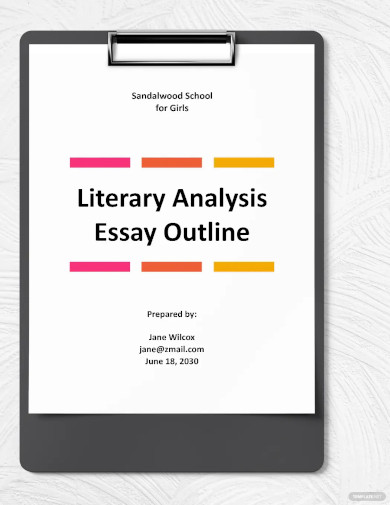
- Google Docs
2. Quotation Literary Analysis Essay Example
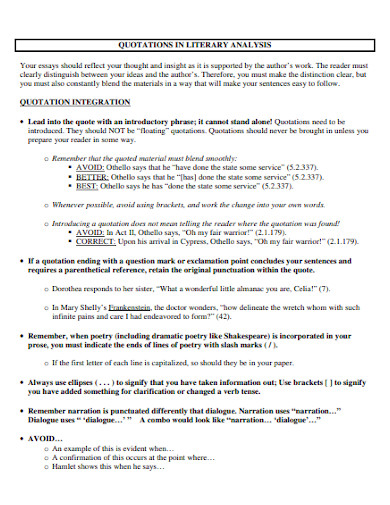
Size: 33 KB
3. Printable Literary Analysis Essay Example

Size: 252 KB
4. Building a Literary Analysis Essay Example

Size: 195 KB
5. Literary Analysis Essay Score Sheet Example
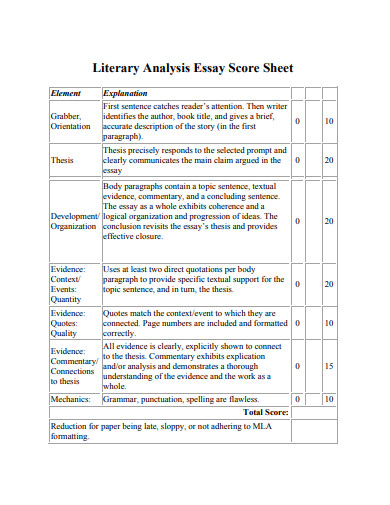
Size: 81 KB
6. Sample Literary Analysis Essay Example
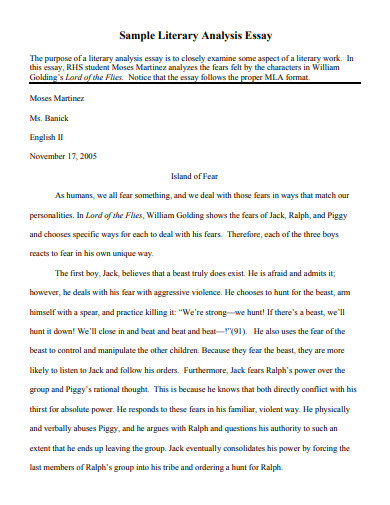
Size: 63 KB
7. Literary Analysis Essay Checklist Example
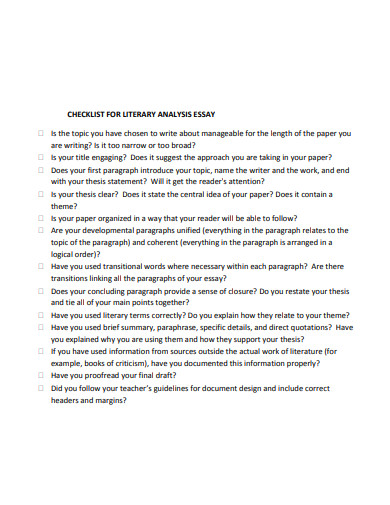
Size: 180 KB
8. Literary Analysis Essay Outline Example

Size: 51 KB
9. Editable Literary Analysis Essay Example
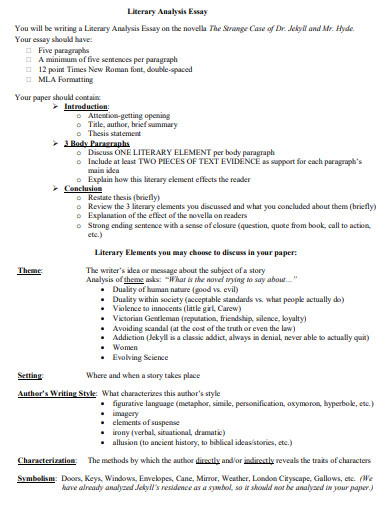
Size: 336 KB
10. Peer Editing Literary Analysis Essay Example
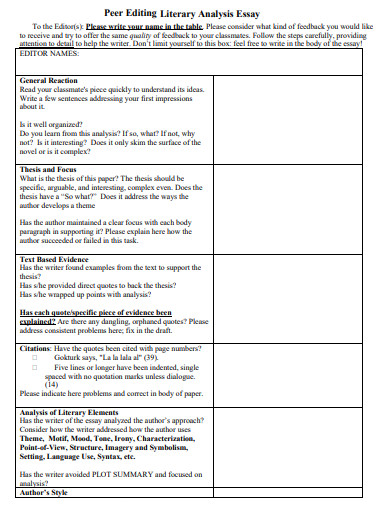
Size: 226 KB
11. Professional Literary Analysis Essay Example

Size: 41 KB
12. Literary Analysis Assessment Outline Essay Example
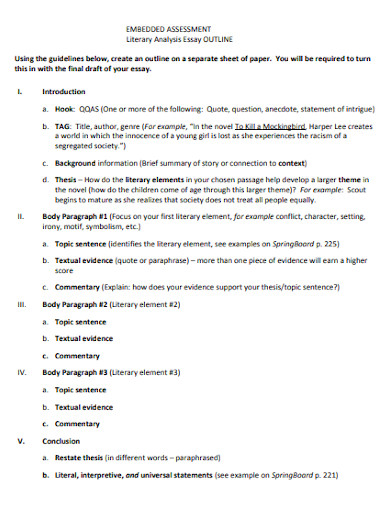
Size: 61 KB
13. High School Literary Analysis Essay Example
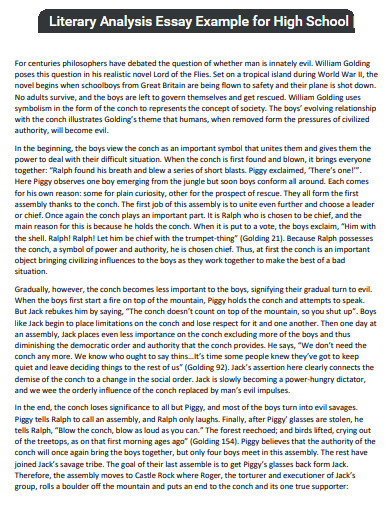
Size: 95 KB
14. Evaluation of a Literary Analysis Essay Example
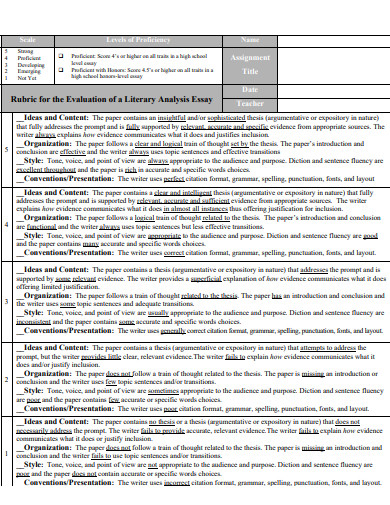
Size: 22 KB
15. Graphic Organizer Literary Analysis Essay Example

Size: 306 KB
16. Literary Analysis Essay Structure Example
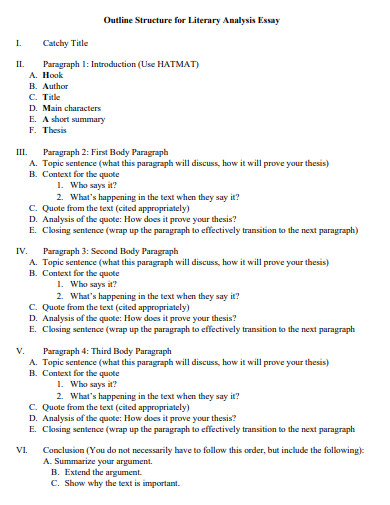
Size: 178 KB
17. Literary Analysis Essay Writing Example

18. College Literary Analysis Essay Example
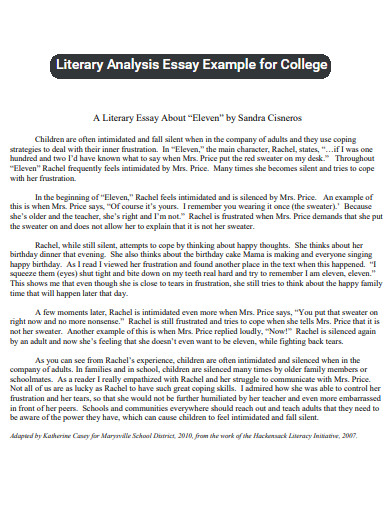
Size: 468 KB
19. Literary Analysis Essay Rubic Example

Size: 644 KB
20. Simple Literary Analysis Essay Example
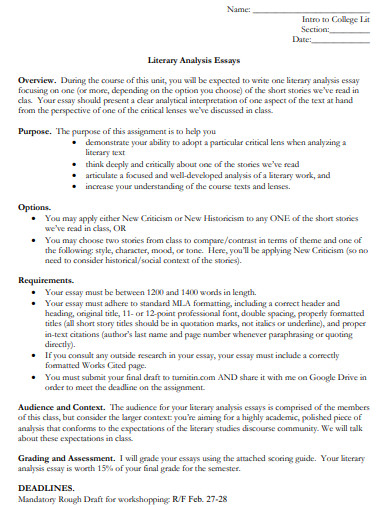
Size: 88 KB
21. Writing a Literary Analysis Essay Example
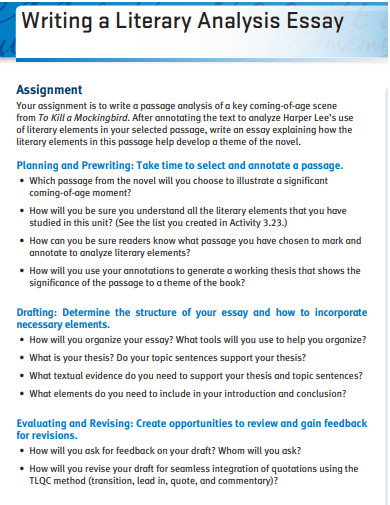
Size: 500 KB
22. Introduction to Literary Analysis Essay Example
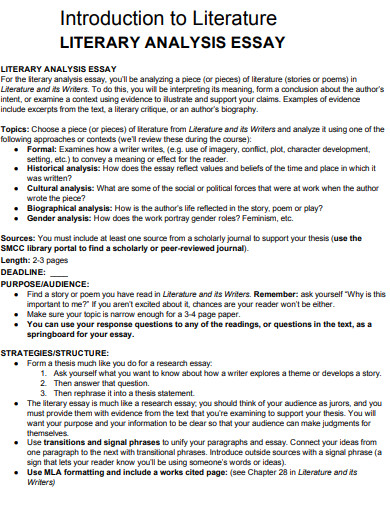
Size: 368 KB
23. Short Story Literary Analysis Essay Example

Size: 103 KB
24. 8th Grade Literary Analysis Essay Example
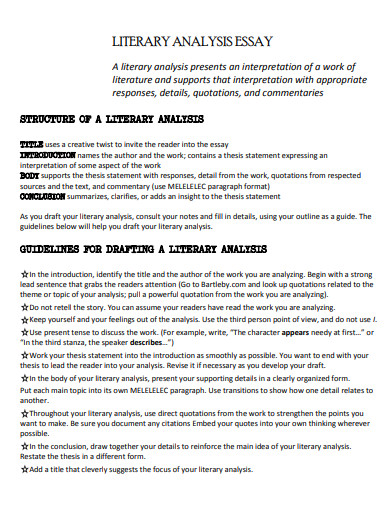
Size: 278 KB
25. Literary Analysis Essay Assignment Example
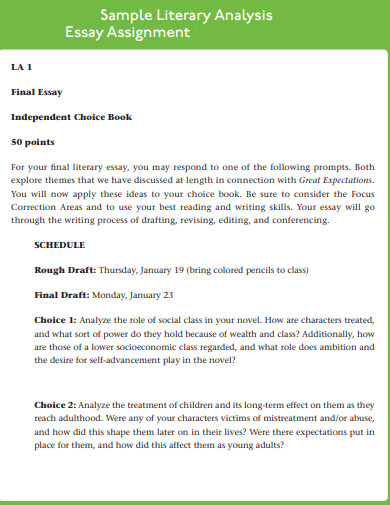
Size: 47 KB
26. Literary Analysis Video Essay Example
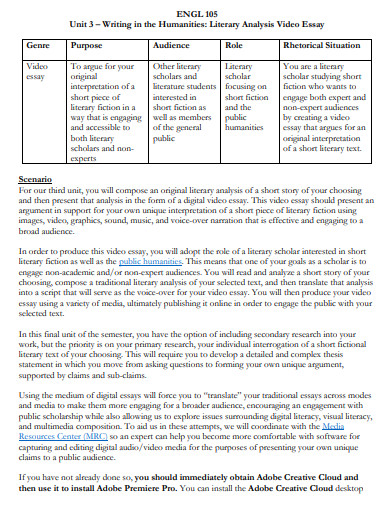
Size: 208 KB
27. Student Guide for Literary Analysis Essay Example
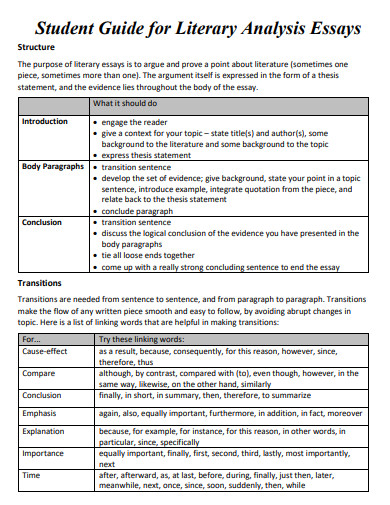
Size: 956 KB
28. MLA Literary Analysis Essay Example
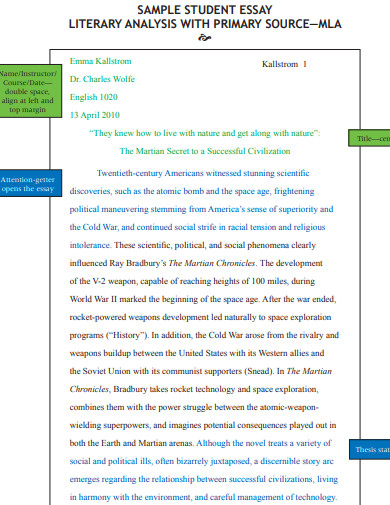
Size: 116 KB
29. Draft Literary Analysis Essay Example

Size: 112 KB
30. 9th Grade Literary Analysis Essay Example

Size: 93 KB
31. Literary Analysis Essay Guide Example
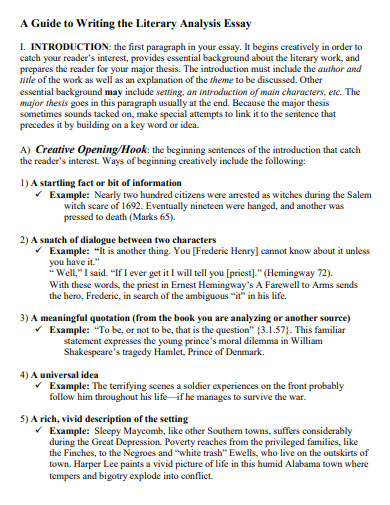
Size: 36 KB
What is a Literary Analysis Essay?
A literary analysis essay is a critical examination and interpretation of a literary work. It involves analyzing various elements such as plot, characters, themes, and literary devices to uncover deeper meanings and insights. By dissecting the text and exploring its nuances, readers can gain a deeper appreciation for the author’s intentions and the work’s impact. A well-written literary analysis essay provides a comprehensive analysis that goes beyond surface-level observations.
How to Write a Literary Analysis Essay
Before we dive into the examples, let’s outline the steps involved in writing a literary analysis essay:
Step 1: Choose a literary work:
Select a literary work that you want to analyze. It could be a novel, short story, poem, or play. Ensure that the chosen work is rich in literary elements and offers ample material for analysis.
Step 2: Familiarize yourself with the work:
Read the literary work carefully, taking note of important plot points, characters, themes, and literary devices. Pay attention to the author’s writing style and the overall tone of the work.
Step 3: Develop a thesis statement:
Craft a strong thesis statement that encapsulates your main argument or interpretation of the literary work. Your thesis should be clear, concise, and debatable, providing a roadmap for your analysis.
Step 4: Gather evidence:
Collect evidence from the literary work to support your thesis statement. Look for specific examples, quotes, and literary devices that reinforce your analysis. Take note of the context in which these elements appear.
Step 5: Organize your essay:
Create an analysis paper outline to structure your essay effectively. Divide your essay into introduction, body paragraphs, and conclusion . Each body paragraph should focus on a specific aspect of your analysis, supported by evidence.
Step 6: Write your essay:
Start with an engaging introduction that provides background information and introduces your thesis statement. In the body paragraphs, analyze different aspects of the literary work, providing evidence and explanations. Ensure a smooth flow between paragraphs. Conclude your essay by summarizing your main points and reinforcing your thesis .
What are some examples of literary devices?
Literary devices are techniques used by authors to enhance their writing and convey meaning. Examples include metaphors, similes, personification, alliteration, and symbolism. For a comprehensive list and explanations, refer to Literary Devices .
Are there any specific examples of short story analysis essays?
You can find examples of short story analysis essays in PDF format here . These examples provide insights into analyzing the elements of a short story effectively.
How does context impact literary analysis?
Context plays a crucial role in literary analysis as it helps readers understand the historical, social, and cultural background in which the literary work was written. It provides insights into the author’s intentions and influences the interpretation of the text.
Text prompt
- Instructive
- Professional
Analyze the theme of courage in a novel for your Literary Analysis Essay.
Write about the use of symbolism in a short story for your Literary Analysis Essay.

IMAGES
VIDEO
COMMENTS
We always start with simple paragraphs. Yes, this is basic, but if your students cannot write excellent paragraphs, their five paragraph essays will be train wrecks. Trust me! We spend a while cementing paragraph structure: Topic Sentence. Detail #1. Detail #2. Detail #3. Closing Sentence.
Follow your outline, using each of your supporting points as the topic sentence of its own paragraph. Use descriptive words to get your ideas across to the reader. Go into detail, using specific information to tell your story or make your point. Stay on track, making sure that everything you include is somehow related to the main idea of your ...
Constructing a 5 Paragraph Essay. Read below for a brief five-paragraph essay instructional unit to help you guide your child in writing an exceptional essay. 1) How To Write An Introduction. In the five-paragraph essay format, the introduction is vital in grabbing the reader's attention and holding it throughout the essay.
Plan the essay. Write an outline that lists each section of the essay, including an introduction, middle and a conclusion. Paragraphs that support the thesis will be in the middle of the essay. Write a first draft of the essay. The introduction should catch the readers' attention and contain the thesis statement.
5th grade writing: narrative writing. A narrative is a story. Whether inspired by a book, real events, or your child's imagination, your child's story should start by introducing a narrator, characters, or a situational conflict. Fifth graders will be asked to use classic narrative devices like dialogue, descriptive words, and character ...
Our fifth grade essay writing worksheets will give them the encouragement they need to remain composed while composing. From understanding various text types and their purposes in the organization of an essay to synthesizing research to write essays, our worksheets will provide the practice and reinforcement students need.
The writing prompt will be something like this: Think about a time you did something that made you feel guilty. Describe what happened. To answer this, your child will have to tell the story of a time they did something wrong and what the consequences were. They will likely make use of the "five senses" and discuss how they felt moment-to ...
Students can use the following steps to write a standard essay on any given topic. First, choose a topic, or ask your students to choose their topic, then allow them to form a basic five-paragraph by following these steps: Decide on your basic thesis, your idea of a topic to discuss. Decide on three pieces of supporting evidence you will use to ...
The essay writing process consists of three main stages: Preparation: Decide on your topic, do your research, and create an essay outline. Writing: Set out your argument in the introduction, develop it with evidence in the main body, and wrap it up with a conclusion. Revision: Check your essay on the content, organization, grammar, spelling ...
The hamburger essay structure consists of five paragraphs or layers as follows: Layer 1 - The Top Bun: The Introduction. The uppermost layer is the introductory paragraph which communicates to the reader the purpose of the essay. Layers 2,3, & 4 - The Meat Patties: The Body Paragraphs.
Grade 5, Standard 1 (W.5.1) Write opinion pieces on topics or texts, supporting a point of view with reasons and information. EXAMPLES: Writing Standards: Grade 5, Standard 4 (W.5.4) Produce clear and coherent writing in which the development and organization are appropriate to task, purpose, and audience. EXAMPLE: Language Standards: Grade 5 ...
Title. STOCK4B-RF / Getty Images. Choose a title for your essay that expresses your primary idea. The strongest titles will include a verb. Take a look at any newspaper and you'll see that every title has a verb. Your title should make someone want to read what you have to say. Make it provocative.
There is an Outline worksheet on the back of this page to help you start planning the content, order and organization of your essay. Paragraph 1: Introduction -- If possible, open with an attention-getting device to interest the reader (perhaps a quote or question). Introduce the topic of your essay in general, and present some context for this ...
Hooks, topics and reasons. Students plan and write an introductory paragraph including a hook, a topic sentence and a brief summary of 3 reasons that would be expanded upon in a full essay. Worksheet #1 Worksheet #2 Worksheet #3 Worksheet #4. Worksheet #5 Worksheet #6. Similar: Writing conclusions Five-paragraph essays.
Luckily, five-paragraph essays are really easy to write if you know the expected format and give yourself the time you need to write it. To write your five paragraph essay, draft your introduction, develop three body paragraphs, write your conclusion, and revise and edit your essay. Part 1.
Table of contents. Step 1: Prewriting. Step 2: Planning and outlining. Step 3: Writing a first draft. Step 4: Redrafting and revising. Step 5: Editing and proofreading. Other interesting articles. Frequently asked questions about the writing process.
Narrative Writing Checklist: Grade 5 I write narratives to develop real or imagined experiences or events using effective techniques, descriptive details, and clear event sequences. How is my Narrative writing? Did I write like a fifth grader? YES NO zation Introduction I wrote an engaging beginning and established a setting or situation for my
This video contains steps in writing an opinion essay, based on Journeys Grade 5 Book page 352-353. This video is made solely for the purpose of distance lea...
Make a claim. Provide the grounds (evidence) for the claim. Explain the warrant (how the grounds support the claim) Discuss possible rebuttals to the claim, identifying the limits of the argument and showing that you have considered alternative perspectives. The Toulmin model is a common approach in academic essays.
The Online Writing Lab at Purdue University houses writing resources and instructional material, and we provide these as a free service of the Writing Lab at Purdue. Students, members of the community, and users worldwide will find information to assist with many writing projects. Teachers and trainers may use this material for in-class and out ...
An essay is a piece of writing where the author proposes an argument, an emotion, or tries to initiate some sort of debate. It's often used to present the author's ideas in a non-fictional manner. It can cover basically any topic in the world - from political discourse through to art criticism and everything in between.
What makes one essay stand out among countless submissions while others barely make the grade? The answer lies in both the content and the execution of your writing. Strong content that is poorly executed can lead to disappointing results, just as weak content cannot be saved by writing style alone. A strong essay needs to be balanced.
They really need a structure for this. So, the typical essay, before they get to me, goes like this, and it is a good precursor: Introduction that states your thesis and 3 major reasons to support your claim. Reason 1. Reason 2. Reason 3. Conclusion that looks a whole lot like the introduction.
Explore a collection of 30+ literary analysis essay examples in Word, Google Docs, and PDF formats. Learn how to analyze literature effectively, understand literary devices, create a strong thesis, and provide a comprehensive conclusion. Discover the importance of context, analogies, and literature reviews in crafting a well-rounded analysis.
SAT Practice on Khan Academy® is free, comprehensive, and available to all students. With personalized plans, practice tests and more, Khan Academy is good preparation for any test in the SAT Suite.